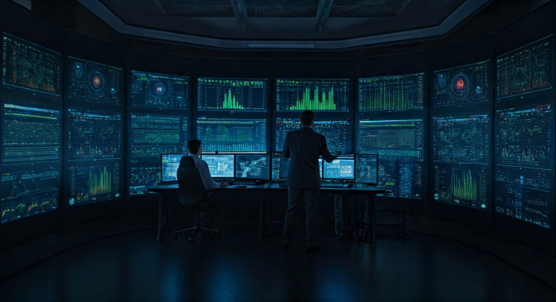Understanding the Basics of Automatic Manufacturing Systems
Understanding the Basics of Automatic Manufacturing Systems
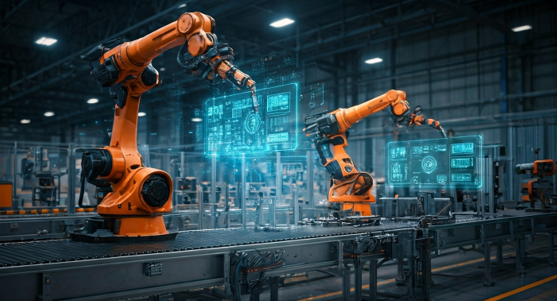
Key Highlights
- Automatic manufacturing systems use new technology like industrial robots, control systems, and AI to make production faster and smoother.
- They help make product quality better by cutting down on human error and keeping things the same through different manufacturing processes.
- The main kinds of automation are fixed, programmable, and flexible systems. These can handle high-volume jobs, batch work, or changing production needs.
- Main parts like robotic arms, PLCs, and automation software help the machines talk to each other without problem.
- These systems be good for supply chain management, help lower labor costs, and boost economic growth in modern manufacturing.
Let’s take a look at the basics of automatic manufacturing systems and see what their important benefits are.
Introduction
The manufacturing process today is changing fast because of industrial automation. Modern manufacturing now uses systems that lower human intervention. This helps companies work faster and better. It also makes their work more flexible. These automatic manufacturing systems help businesses handle more customer needs and grow more. By cutting down on mistakes and keeping product quality steady, automation is now a must in staying strong in the market. Knowing the basics of automation is vital if you want to keep up with the changes in modern manufacturing.
The Complete Guide to Automatic Manufacturing System
What Are Automatic Manufacturing Systems?
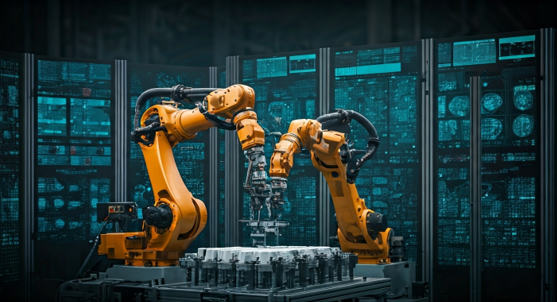
Automatic manufacturing systems are a new way to run the manufacturing process. In these systems, technology takes over jobs that people used to do. Automatic systems help make the production process smoother. They make things faster and more exact, while costs go down.
With the help of robotics, control systems, and sensors, companies take care of the same jobs again and again and keep the quality steady. Automatic systems allow manufacturing plants to easily switch and make things for orders that need something special. Their ability to change and work well is the reason why automatic systems are now such an important part of industrial automation.
Definition and Key Concepts
An automatic manufacturing system is a setup that runs by itself. It uses industrial automation to control the production process. This kind of system cuts down on human intervention. Machines and control systems now do many tasks that people used to do. This helps to lower the risk of human error in the work.
One of the most important ideas here is using control systems for the job. Tools like PLCs manage how the production process goes. These systems work by set rules. Every task gets done in the right way, every time. For example, automated conveyor belts move each product where it needs to go. Products get handled without someone watching them all the time.
Sensors and robots also have big jobs in the manufacturing system. They watch and adjust what happens based on real-time data. They help make sure every product is done right. These systems keep looking for ways to do things better, so there is always continuous improvement. With these tools, people can stop doing boring tasks and spend more time on hard work that needs choices. This makes things run better and people can get more done.
Evolution from Manual to Automatic Manufacturing
The journey from using manual processes to working with fully automatic systems shows the big impact of digital transformation. In the past, manufacturing was mostly done by people. Manual processes were a big part of making things in factories. These ways worked at that time, but they had some problems with speed. They did not always give precise results and were hard to make bigger.
With the coming of numerical control (NC) tools, things started to change. Machines began doing tasks that people had to do before. These tasks were set up ahead of time, so there was less need for human intervention. The fourth industrial revolution moved things forward even more. New digital technologies like IoT, robotics, and AI were used together. Production lines became more automatic. This new way also reduced the need for people to step in every time.
Now, automatic systems let factories work at a level of efficiency not seen before. Jobs like quality control, assembly, and material handling are now done well by machines. This change has shaped modern manufacturing. Automation is now a main part of productivity and new ideas in factories.
Major Components of Automatic Manufacturing Systems
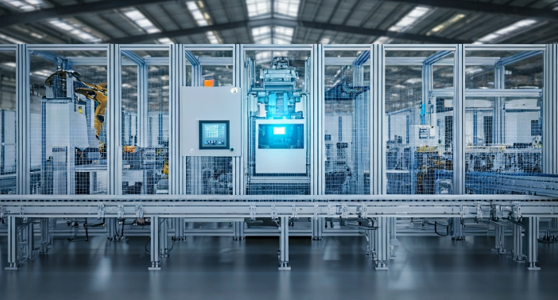
Automatic manufacturing systems have key parts that work together. These parts include control systems, hardware, and software. In the hardware, you find things like robotic arms, conveyers, and machine tools. These do the hands-on work. For example, they cut, shape, and put parts together on the line in manufacturing plants.
Software is also very important. It uses things like programmable logic controllers and automation tools to run the system. The software gives the instructions that help all parts work well together. With the help of both hardware and software, everything keeps moving smoothly. That makes sure there is good accuracy and efficiency across the plant. In the next sections, we will talk more about the hardware and software parts.
Hardware: Machines, Robots, and Conveyors
At the core of an automatic manufacturing system, you will find strong hardware like machine tools, industrial robots, robotic arms, and conveyors. Machine tools are used in places like automotive manufacturing. They do cutting, drilling, and shaping work with great care. These tools are needed because they help workers do important jobs in these industries.
Industrial robots, like robotic arms, often repeat tasks such as putting parts together or packing items. They do this work with high accuracy and help lower the risk of human error. Because of this, manufacturing plants use these robot systems to keep up with the needs of the production line. The quality stays even and good each time.
Conveyors act as the backbone in any production line. They move parts and products from one area to another quickly. Sensors on automated conveyors watch where items are, which helps stop hold-ups. In the world of modern manufacturing, this hardware allows people to handle tasks like putting things together or checking them in a fast, careful way. This ensures everything in the manufacturing system works smoothly.
Software: Control Systems and Automation Platforms
The software that runs autonomous systems is key in industrial automation. Control systems like PLCs and distributed control systems help machines do what they need to by using preset programs. These systems work to have everything in the production process move in the right way at the right time.
Advanced automation platforms now use the newest technologies, which includes artificial intelligence. These AI tools can watch over how things work, guess what might happen next, and help people make changes on the spot. This makes the production speed better and cuts down on how much energy is used.
Process automation software helps teams by giving them useful information. It finds things that are not working well and lets people fix them straight away. With IoT working together with process automation, there is better connection between different parts of serious manufacturing work. These platforms bring both hardware and software together, so production stays steady and runs well.
Types of Automatic Manufacturing Systems
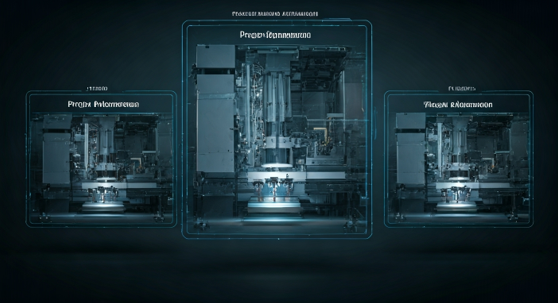
There are different types of automation, and each one fits certain production needs in a manufacturing system. Fixed (or hard) automation is the type of automation that works best for jobs that need to be repeated many times in large numbers. On the other hand, programmable automation is better for batch production, where the tools and machines need to be changed after each batch. Flexible (or soft) automation is used when changes happen often, and work needs to move smoothly from one setup to another.
Each main type of automation uses different industrial automation tools. These help make work faster, lower costs, and meet the needs of the market. Let’s take a closer look at these main types of automation so you can see what makes each one special and what advantages they give.
Fixed (Hard) Automation
Fixed automation, also known as hard automation, is a setup in the manufacturing process that does not change easily. In this type of system, you get equipment made especially for certain jobs. This equipment, like transfer lines and machine tools, be used for making a lot of the same parts over and over. Hard automation is known for its fast production speed and for keeping costs down once things are up and running. But, the money needed to get started can be quite high. You often see this kind of setup in the automotive industry. It works well there because you need the same quality every time, and there is less need for human intervention.
Programmable Automation
Programmable automation gives flexibility made for batch production. This type of automation is not like hard automation. It can change to make different things. That makes it good for jobs in the automotive industry and other places where designs often need to be different.
In this setup, people use programmable control tools. One example is NC machinery. These are just machines that can be asked to do many tasks. That helps when you have to make shorter runs in production. In the automotive industry, this type of automation helps a lot. It is great for making small runs of custom vehicle parts. This shows how it can be used in different ways.
Each time the program is changed for a new batch, there will be some extra time needed to set up. But, if the work changes often or if demand goes up or down, programmable automation is a good choice. This way, it balances being fast and being flexible. That is why it is an important type of automation in modern manufacturing.
Flexible (Soft) Automation
Flexible automation systems give you many ways to improve the manufacturing process. This type of automation helps you change fast when different products or batch sizes are needed. By using programmable automation and modern control systems, you can handle many kinds of work with less help from people. In the automotive industry, flexible automation uses robotic arms and machine tools the most. These help with hard assembly steps. When businesses start using digital transformation, they get the good things that come with flexible automation, like lower labor costs and faster production speed.
Core Functions and Processes in Automated Manufacturing
The automated manufacturing system changes how the main tasks are done, like handling materials, putting parts together, and checking product quality. With process automation, the manufacturing system gets faster and manages various manufacturing processes more smoothly across the whole supply chain.
These systems help reduce waiting times in operations. They keep handling and checking work moving with very little need for human intervention. Now, let’s look at how material transportation, building products, and checking quality are so important in automated manufacturing systems. This will help us see what they do in the supply chain and how they help the whole manufacturing system work better.
Material Handling and Transportation
Material handling and moving things are at the heart of the supply chain in an automated manufacturing system. In this system, you will find tools like conveyors and automated guided vehicles (AGVs). They move materials from one place to another in the production process in a smooth way.
These systems make supply chain management better by making workflows work well and cutting down on delays. For example, when conveyors have sensors, they keep track of how goods move. This stops bottlenecks from happening in the production process. With this kind of setup, material handling in the manufacturing system is easier, and you get fewer mistakes.
Automated solutions do jobs like loading and unloading with great accuracy. People do not need to get involved in risky jobs. This makes the production space safer and gives you a system you can trust more.
Assembly, Inspection, and Quality Control
Automated systems help the assembly process by using industrial robots that do the same tasks in the same way each time. These robots put parts together fast and help lower human error. This makes sure the products stay in line with the set product quality standards.
For inspection and quality control, automation tools use sensors that can find defects right when they happen. Automated cameras and machines check products very well, giving more accurate results than manual processes.
With less human error and more focus on continuous improvement, these systems increase how steady the product quality can be. This is why automated manufacturing is now a big part of modern quality control.
Benefits of Implementing Automatic Manufacturing Systems
Putting automatic manufacturing systems in place has many benefits for the manufacturing process. With automation technology, companies can boost production speed and work more efficiently. This also helps cut down on downtime. The use of these systems makes products more consistent and of better quality. It lowers the risk of human error, too, and helps meet strict standards.
Also, adding artificial intelligence and real-time data to these systems makes supply chain management work better. This leads to stronger economic growth and gives businesses a better chance in tough markets. By lowering the risk of human error through automation technology, companies get an edge in many ways during the manufacturing process.
Increased Productivity and Efficiency
Using automatic manufacturing systems helps improve how things are made in different industries. The use of robotics and new control systems makes the production line smoother. This means there are fewer manual processes, so labor costs go down. The production speed goes up, and this helps use resources in the best way.
Companies can now meet higher demand for products but still keep good product quality. Data analytics is also used, which helps companies keep making things better every day. They can adjust things in real time and lower the risk of human error. This new way of working is not just good for economic growth. It also helps companies do well in the fourth industrial revolution.
Enhanced Consistency and Product Quality
Automation technology is important in the manufacturing process. The use of industrial robots and programmable automation systems helps make work more the same every time. With less human intervention, the risk of human error goes down. Control systems and programmable logic controllers let people have better control of the assembly process. This means that products will be more alike and made with good quality. With this kind of consistency, the supply chain and supply chain management get better. In the end, this makes things work well and brings many benefits for a business.
Common Challenges and Solutions in Automatic Manufacturing
Adding automatic manufacturing systems to your old setup can be hard. The main problem is making sure the new machines work well with the old technology. To fix this, you need to plan well. Using programmable logic controllers can help your systems talk to each other better. There is also the risk of human error when your team learns new tools and ways of working. It is key to train your staff to lower that risk of human error. Try hands-on workshops and show the team how data analytics can help. This will help everyone get used to automation faster and still keep up the work pace.
Integration with Existing Systems
Seamless integration with current systems can be tough in automatic manufacturing. The company must make sure that new automation technology works well with what is already there, not get in its way. Sometimes, this means the control systems and programmable logic controllers need to be lined up with old equipment. This helps the whole production line talk to each other without problems. Also, using data analytics is important. It lets people check how things are going and make continuous improvement. This way, you can lower risks like human error and bring down energy consumption across the supply chain.
Workforce Adaptation and Skills Development
Using automation technology in manufacturing means that the workforce needs to change what they know and what they do. As industrial automation grows, employees have to get used to using new machines and programmable logic controllers. This also helps to cut down on human error. Companies should have training programs that focus on the latest digital transformation trends. This makes sure that people learn the right skills for the job. By focusing on continuous improvement, companies can make sure everyone keeps getting better at what they do. This will help workers match what modern production needs and will increase both productivity and efficiency.
Conclusion
Bringing automatic manufacturing systems into a business can be a big turning point. This step can help companies boost productivity and efficiency. It also lets them improve product quality. These changes help a business stay on top in modern manufacturing.
There are challenges, such as making sure all systems work well together and helping workers get used to new ways of working. But, with some good planning, these problems can be handled and will not hold a business back for long.
Using this technology is not just good for one company. It helps drive economic growth for many people. It also follows the ideas of the fourth industrial revolution. This helps companies stay strong and ready for new changes in the market.
Frequently Asked Questions
What industries use automatic manufacturing systems most commonly?
Automatic manufacturing systems are used a lot in car, electronics, food, and medicine industries. These areas see higher efficiency and less labor costs because of automation. Product consistency is also better. This is why automation has become a key part of their work.
How do automatic manufacturing systems improve workplace safety?
Automatic manufacturing systems help make the workplace safer. These systems lower the need for human intervention in dangerous tasks. Because of this, the risk of accidents goes down
Automation technology uses advanced sensors to watch over the work area. This helps check if everything meets safety standards. With this, people can act fast if something seems risky.
In the end, these changes make it a safer place for everyone to work.
What is the typical cost of implementing an automatic manufacturing system?
The price to set up an automatic manufacturing system can change a lot. This is because it depends on how complex the system is, how big it is, and which technology you use. In most cases, companies will need to spend from a few thousand dollars to many millions. The final cost will depend on what each business needs and what their goals are for the manufacturing system.
Can small businesses benefit from automation in manufacturing?
Yes, small businesses can get a lot out of using automation in manufacturing. Automation helps make work easier and runs things more smoothly. It lets you lower labor costs, cut down on mistakes, and boost how much you get done. This also means better quality. When you use automation, your small manufacturing business can keep up with others in the market. It helps you work faster and meet what customers want.
How will automation impact future jobs in manufacturing?
Automation is set to change the face of manufacturing jobs. There will be a bigger need for skilled people who can run and look after new technologies. As a result, many routine jobs may go away. But at the same time, there will be new chances in system design, programming, and data analysis. Because of this, the workforce will have to learn new skills and move into these roles. This will help keep things fresh and growing in the industry.
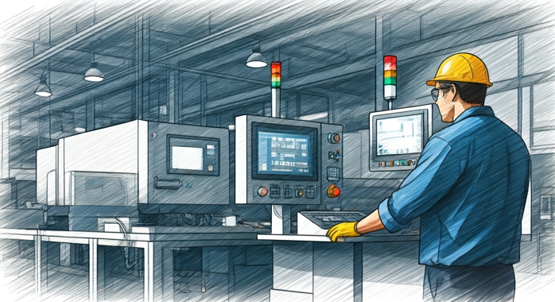
Automation in a factory helps make the production process better and faster. The use of programmable logic controllers (PLCs) and top-notch control systems cuts out human error. This keeps the quality high and downtime low.
Automated systems help save money because machines do repetitive tasks much better than people can. This leads to less waste and lets the workforce work on complex tasks that need more skill. All of this creates new opportunities for workers and makes the overall efficiency of the production environment better.
Cost Reduction and Improved Efficiency
Cutting down costs and making things work better are very important for manufacturing companies these days. When a company uses automated manufacturing systems, it can lower human error and speed up how things get made. The use of advanced robotics, programmable logic controllers, and smart manufacturing tools can help fix bottlenecks and help companies make better use of what they have in the production environment. By doing this, companies save money, boost their overall efficiency, and get ready to change when the market or customer needs shift.
Enhanced Safety and Quality Control
By bringing in robotics and automation technology, the production process becomes a lot safer. This big step lowers the risk of accidents at work. In the manufacturing industry, collaborative robots—called cobots—work with people to take on repetitive tasks that can be dangerous. This helps cut down on human error.
With automation, quality control also gets better. It uses sensors and vision systems to watch the entire production process in real time. This way, every product meets the high standards set by the industry. Because of this, there is less downtime and fewer problems with defects, and the quality stays consistent.
Challenges and Considerations in Factory Automation
Dealing with factory automation brings many things to think about. The cost at the start for things like programmable logic controllers and robotics can be high. So, you need to take a good look at ROI to decide if the long-term gain is worth it. The workforce also has to change with automation. Workers need to learn new skills to work with automated systems. Setting up training helps close the learning gap. It also makes it easier for people and machines to work together. This kind of teamwork cuts down on human error and helps the manufacturing process run well. It is important to get everyone on board to make automation work and get the best overall efficiency out of it.
Upfront Investment and ROI Analysis
Looking at the upfront investment for an automated manufacturing system shows that there are many things to think about. These things affect the overall efficiency of the whole production environment. To get the best value out of your manufacturing system, you need to pick the right mix of programmable logic controllers (PLCs), industrial robots, and other types of machinery. This can help you make a good ROI analysis. When you add up the possible savings from spending less on labor and lowering human error, you get a better picture of your finances.
Using analytics and enterprise resource planning (ERP) systems also helps. With ERP, your team can track important data about how well your system is working. This makes it easier to make smart choices about investments in automation technology for your automated manufacturing system. So, you can get a clear view of how much these choices can pay off for your company.
Workforce Adaptation and Skill Development
Moving to automation means the workforce needs to adapt and learn new skills. When factories bring in automated systems and advanced tools, people need to be ready. It's important to have training that covers robotics, analytics, and how to run machines. This will help employees handle automated systems every day and cut down on human error. When companies support ongoing learning, the workforce will be better at solving complex tasks and handling change. This focus on being ready for anything helps companies stay strong and make the most of new opportunities in a changing, automated world of work.
Real-World Examples of Factory Automation
Many industries use automation and see big changes. In the automotive field, assembly lines use industrial robots to get more precision and to cut down on human error. This helps raise the number of cars they make. In the food and beverage business, sensors and automated machines help pack products faster. These tools cut downtime and make quality control better. These real-world changes show how different types of automation work well. Both programmable and flexible automation help smart factories turn old ways of working into something much more efficient.
Automotive Industry Automation Success Stories
Examples of automation in the automotive industry show big steps forward in how we make vehicles. When companies use industrial robots on assembly lines, they make the production process smoother. This helps cut down on human error and boosts overall efficiency. With flexible automation, manufacturers can switch to making different products quickly. There is less downtime, and this lifts productivity.
Smart factories are leading the way by using real-time analytics and programmable logic controllers. They use this data and technology to run operations better every day. Bringing in automation technology changes complex tasks into easier jobs and helps companies stay strong in the market.
Food & Beverage Manufacturing Automation
Automation in the food and beverage sector helps the production process run better and faster. It uses new control systems like programmable logic controllers (PLCs) and vision systems. These systems help people avoid mistakes and give real-time updates on the whole process. With automated systems, workers can handle the ingredients and manage the packaging in a more accurate way. This means there is less downtime, the assembly lines flow quicker, and everything runs smoothly. These new ideas in automated technology let companies keep up with high standards and also bring new opportunities. Now, businesses can change the way they work and react quickly when customers' needs change.
Future Trends in Factory Automation
Factory automation keeps changing how manufacturing works. Now, artificial intelligence and machine learning help with fixing machines before they break and making better choices. This means companies can be more efficient with their work. As smart factories grow, the use of sensors in IoT helps to watch things in real time. These sensors send data to analytics tools, so information from complex systems is always up-to-date. With this, people can make quick changes when needed. Also, there is a big focus on using green and energy-saving technology. Companies now try to work in ways that are good for the environment. This shift creates new opportunities in production, as automation and smart ideas help solve both efficiency and environmental problems together.
Artificial Intelligence and Machine Learning Integration
Bringing artificial intelligence and machine learning into factory automation changes how things are made. With these advanced tools, companies can make work better and improve overall efficiency. These systems help cut down on human error in the process. They use algorithms and analytics to look ahead and warn people about possible machine failures. This way, there is less downtime, and things can keep moving.
AI can also help with quick decision-making in hard or tricky systems, so production runs in real time and meets the current demand. As smart factories grow and change, using AI and automation together will bring new opportunities for businesses to do better and come up with new ideas across many factory jobs.
Sustainability and Green Manufacturing Initiatives
Bringing sustainable ways into the automated manufacturing system helps factories be more efficient and use less of their resources. When you use programmable logic controllers (PLCs) and sensors, you can keep an eye on energy use in real time. This helps to make the process better and waste less. Using flexible manufacturing systems in the manufacturing industry also means you can work with eco-friendly materials and have less chance for human error. Going for green choices does not just support a better world, but it also brings in consumers who care about the environment. There are new opportunities for the manufacturing system to grow when it stays automated and uses PLCs and sensors.
Conclusion
Moving to an automatic manufacturing system is now very important for factories that want to be better and faster. When businesses use things like automation technology, they make their ways of making products much better. This helps them lower human error and makes quality control stronger across different parts of the manufacturing industry. Using robotics, sensors, and programmable logic controllers is a good way to add automation to the workflows these companies already use.
As the manufacturing industry keeps moving forward, being able to use new automation technology can open up new opportunities for getting ahead. With automated systems, factories become more ready to face competition in the world and be more sustainable as well. When factories use automated solutions, they can be better than others and stay strong in the market.
Frequently Asked Questions
What is the best starting point for factory automation?
The best way to begin with factory automation is to look at your current ways of working. Find where problems or slow spots, known as bottlenecks, exist. Take the time to study how production moves step by step. Talk to everyone involved to get their thoughts. Focus on parts of your work that could most help if they were faster or easier. This helps you plan well for automation and get the most out of your efforts.
How does automation affect employment in manufacturing?
Automation in manufacturing can take over jobs, as machines start to do some tasks done by people. But it can also help to make new jobs that need advanced skills. This means that the workforce has to learn new things to keep up. The automated workplaces show how important it is for people to keep training and growing their skills so they can do new jobs when things change. This helps employees be ready for the new roles in a world with more automation.
How long does it take to see ROI from factory automation?
The time it takes to see ROI from factory automation can be different for everyone. Most people see it happen between six months and three years. The speed depends on a few things, like how big the automation project is, the type of industry, how well it gets set up, and how good the team is at making improvements as they work. These things help to boost productivity and bring costs down over time.
Can small and medium factories afford automation?
Yes, small and medium factories can have automation for their needs. They can do this with options that can grow as they do, money plans to help pay, and tech made just for them. When factories pick ways to use automation that do not cost much, they can get more work done in less time. They can also do better than others in the same line of work. Over time, the factory can get back the money it spends, thanks to fewer work costs and things running better with the help of automation.
What are common mistakes to avoid when automating a factory?
Some common mistakes to avoid in factory automation are not giving enough importance to training employees, not joining new technologies the right way, and not doing a good check on what you get back for your investment. It is also a mistake to forget about taking care of the machines and leaving out people who have a say in the process. These things can stop you from making automation work well and getting better results.
What is an automatic manufacturing system and how does it work?
An automatic manufacturing system is a technology-driven process that utilizes machinery and software to produce goods with minimal human intervention. It streamlines operations by integrating robotics, sensors, and data analytics to enhance efficiency, reduce errors, and increase production speed, ultimately leading to optimized resource management and cost savings.


